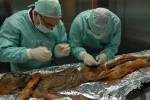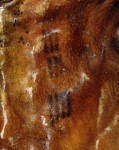 When the full genome of Otzi the Iceman’s mitochondrial DNA was mapped in 2008, researchers found that his subhaplogroup type matched no modern samples, that barring the existence of some rare isolated genetic strain of people in the Alps, his maternal line had gone extinct. Mitochondrial DNA is inherited from women, so the 2008 comparisons could only rule out surviving descendants of Otzi’s sisters or aunts, not direct descendants of his or male relatives who shared the same Y chromosome.
When the full genome of Otzi the Iceman’s mitochondrial DNA was mapped in 2008, researchers found that his subhaplogroup type matched no modern samples, that barring the existence of some rare isolated genetic strain of people in the Alps, his maternal line had gone extinct. Mitochondrial DNA is inherited from women, so the 2008 comparisons could only rule out surviving descendants of Otzi’s sisters or aunts, not direct descendants of his or male relatives who shared the same Y chromosome.
Last year, scientists from the Institute for Mummies and the Iceman at the European Academy of Bolzano (EURAC) and from the Institutes for Human Genetics at the University of Tübingen and Saarland University took a sample of his hip bone and sequenced Otzi’s full nuclear genome from it. They discovered all kinds of interesting facts about the 5,300 man, like that he had brown eyes, was lactose intolerant and had a predisposition to cardiovascular diseases. They also confirmed the results of the mitochondrial sequencing which pointed to a shared ancestry with the modern inhabitants of the Tyrrhenian Sea area even though his particular genetic branch didn’t survive.
 It wasn’t a direct study of Otzi’s genes that identified living relatives, however. It was a study exploring the distribution of the Y-chromosome haplogroup G among the population of the Austrian Tyrol, including in remote areas of the Alps. This kind of research can illuminate pre-historic migration routes by tracing the movement of genetic haplogroups and researchers wanted to see how the topography of the Alps affected the movement of peoples. The G haplogroup is common in the Middle East, but rare in Europe. The Tyrol is an exception. In certain areas of the Tyrolian Alps like the Upper Inn Valley there’s a spike in the values of haplogroup G, but in adjacent Landeck the numbers plummet back down to normal European levels. This suggests that Landeck was close to impassable from the south 10,000 to 20,000 years ago.
It wasn’t a direct study of Otzi’s genes that identified living relatives, however. It was a study exploring the distribution of the Y-chromosome haplogroup G among the population of the Austrian Tyrol, including in remote areas of the Alps. This kind of research can illuminate pre-historic migration routes by tracing the movement of genetic haplogroups and researchers wanted to see how the topography of the Alps affected the movement of peoples. The G haplogroup is common in the Middle East, but rare in Europe. The Tyrol is an exception. In certain areas of the Tyrolian Alps like the Upper Inn Valley there’s a spike in the values of haplogroup G, but in adjacent Landeck the numbers plummet back down to normal European levels. This suggests that Landeck was close to impassable from the south 10,000 to 20,000 years ago.
To get a decent statistical sampling for the study, the scientists collected DNA from the Y chromosome of 3,700 Tyrolian men. Among those 3,700, 19 of them were found to share the haplogroup and thus an ancestor with the Iceman.
The team found that about 19 men shared a genetic lineage, called G-L91, with Ötzi. It’s possible that at least one of these men may directly descend from the Iceman, part of an unbroken line of sons going back 5,300 years.
However, “the chances are so extremely low that I would be tempted to say no,” [study co-author Walther] Parson said. “There are just too many other possibilities.”
 None of the 19 men have been notified that they share a common ancestor with the famous man who was bashed on the head, shot with arrows and died in the Ötztal Alps leaving his body to freeze into a most fascinating mummy. Researchers plan to expand the study to neighboring countries that share Tyrolean territory, the Val Venosta in the autonomous Alto Adige region of Italy and the Swiss Engadin valley. They’ve already found research partners in Italy and Switzerland keen to participate.
None of the 19 men have been notified that they share a common ancestor with the famous man who was bashed on the head, shot with arrows and died in the Ötztal Alps leaving his body to freeze into a most fascinating mummy. Researchers plan to expand the study to neighboring countries that share Tyrolean territory, the Val Venosta in the autonomous Alto Adige region of Italy and the Swiss Engadin valley. They’ve already found research partners in Italy and Switzerland keen to participate.
Perhaps once all of Otzi’s likely relatives are located, they’ll have a tri-country family reunion. They should all get a stripey tattoo in his honor.
Interesting post. We never know who are likely to be our ancestors.
Very interesting. People tend to define the different European peoples through what they see now, but if we go back 5.000 years, or even just 1.000 years, the picture would be completely different. The migration processes, specially those from the Middle East to Europe, and the trading circuits prior to the classical age, are much more complex than we believe them to be.
😎 i found this website very handy for my homework thnx for helping :3
:skull: i still didnt find how radiocarbon dating was beneficial to Otzi man
:blankstare: